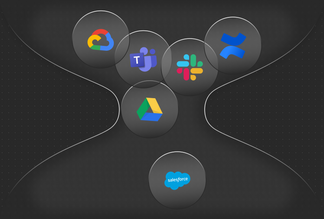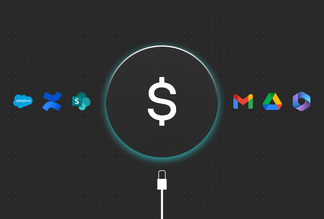

How to run effective meetings — and how to know when to share an async update instead
Our meeting habits are outdated. Scheduling another “quick call” takes seconds and ends up becoming a business black hole. This isn’t to say that all meetings are a giant time suck, just that our communication solutions almost always come back to speaking with someone face-to-face.
There exists a disconnect between the working world and the importance of meetings because we all think that ours is the exception. Yet we’ve been bombarded with statistic after statistic alerting us to the fact that meetings aren’t getting us anywhere.
- 67% of workers say meetings distract them from their ability to make an impact at work.
- 71% of professionals waste time every week due to unnecessary or canceled meetings.
- A study predicted the cost of poorly organized meetings to reach $399 billion in the U.S. and $58 billion in the U.K.
Effective meetings don’t just happen — they require strategizing and iterating. Just as you would analyze a marketing campaign or a product redesign, your meeting format should constantly be evolving to allow employees to perform better and build successful meeting strategies.
The secret formula on how to run better meetings
Meeting management is a skill that everyone has to build, but hardly any of us have formal training in successful meeting strategies.
We’ve accepted the norm that most of our meetings aren’t going to be productive, yet we return to them week after week. Understanding what makes an effective meeting and how to create one is an essential skill for any employee.
Most effective meetings meet the following criteria:
- There’s a clear plan, and everyone has access to it ahead of time
- There are apparent and attainable objectives
- Everyone is engaged
- They produce results
- And have a worthy cause that couldn’t possibly be accomplished asynchronously
So, what’s on the agenda?
You scheduled an hour-long check-in with your team to troubleshoot a project blocker. But now it’s 11:56, and two people have yet to share anything about the project. You check your calendar and realize that one of those two people has a call right after this meeting and can’t stay on past 12. Something went wrong here, and it’s critical that this doesn’t become a recurring issue for your team.
According to a Better Meetings survey, the number one choice for meeting challenges is off-topic conversations. Setting an agenda with a schedule and detailed talking points is one way to ensure the conversation stays on track and relevant to what you’re trying to accomplish.
Share your meeting agenda early and often
Including your meeting agenda in your calendar invite or email is the first step, but you should also make sure it’s widely available through your company’s work hub. Remind yourself the day before the meeting to send the agenda around again to ensure maximum engagement.
Effective meeting tip: Schedule your meeting 5 minutes after the hour
This scheduling trick saves everyone’s sanity, allows for a bathroom or coffee break, and ensures meetings begin on time. Instead of starting a discussion at 11:00, schedule it for 11:05. It gives everyone five extra minutes to arrive refreshed and prepared with the correct documents and materials ready.
Increase meeting engagement
We all know what video conference fatigue feels like at this point.
Something to consider: if you sent a survey around after your meeting asking your attendees if it was necessary in the first place — how many would respond “no?”
If your meeting isn’t building forward momentum, you can’t expect your coworkers to contribute. It would simply be a waste of their time and yours.
Now that your meeting has a set schedule and concrete objectives, encourage active participation and contribution. These two factors look different for everyone, so it’s essential to define them.
An active meeting participant answers questions, takes notes, and follows along. This could look like unmuting themselves in a Zoom conference and answering a question or simply giving a thumbs up with an emoji when asked. While this person has a positive impact on the meeting, they are doing so passively.
Whereas a meeting contributor helps shape the results of the meeting. Contributors can be meeting leaders or attendees who come to the table with data to share, ideas to offer, or questions that help solve problems.
According to Daniel Pink, researcher and speaker on the topic of motivation and author of the book Drive, people need these three elements to “buy-in” to what you are saying to contribute fully.
- Autonomy — Give your employees some control over their work, and have them report out on specific findings at your next meeting.
- Mastery — People want to succeed and are driven to help. Call out someone at each meeting who has accomplished something you admire, and make sure to get to everyone eventually.
- Purpose — Do they see the connection to the greater mission and their role in it? Get specific about your “why” and vocalize it at each meeting.
Effective meeting tip: Everyone’s WFH environment is different
Participation looks different in every meeting, for every knowledge worker. Our work-from-home environments are varied, and keeping this in mind is extremely important for distributed team leadership.
Run meetings that get results
Nobody wants to miss a meeting that is integral to their success, or the company’s, as long as they understand and expect it to be an essential step toward progress. Create a culture where missing last Monday’s weekly briefing means you missed an opportunity to shine, to take on a new project, or to give input that elevates others’ respect for you amongst your colleagues.
The secret? Take your typical meeting time, consisting of a 30-minute data briefing, and cut that time in half. Use the second half of the meeting to create actionable steps, discuss the best paths forward, and create a clear-cut goal with a deadline.
All employees should leave the meeting with an understanding that includes:
- What next steps will take place to achieve results
- The deadline for these steps
- Who the stakeholders and dependencies are
- What barriers they might face, and a few paths through them
At the beginning of the next meeting, take the first few minutes to praise and acknowledge those results from last time to increase continuity in expectations and accountability. Everyone will know you mean business for next time.
Effective meeting tip: Assess the value of your recurring meetings
A lot of meetings have a historical significance to them and haven’t been assessed for their practical value since inception. That progress report that’s been on the calendar since before you joined the company? Maybe that would be better off as an asynchronous meeting.
A work hub can eliminate the need for meetings
With a work hub, you can follow updates to projects you’re subscribed to without adding sync time to everyone’s calendar. Everything is discoverable — from goal completion to the documentation you’ve been searching for.
Meeting agendas, project notes, and the actual work can connect together in a work hub to ensure you’re not using meetings as a productivity crutch. Instead, you’re giving your team back the time they deserve.


